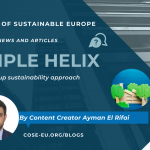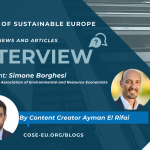Written by: Ayman El Rifai
Reading time: 5 minutes
Green Finance
Green finance, also known as climate finance or sustainable finance, is any kind of financial investment or economic action that aims for protecting and improving the environment. The Organization for Economic Cooperation and Development (OECD) defines the term as: “Finance for achieving economic growth while reducing pollution and greenhouse gas emissions, minimizing waste, and improving efficiency in the use of natural resources”. According to the European Banking Federation, green finance included both environmental aspects such as greenhouse emissions and aspects related to climate change such as renewable energy. Generally, it is the distribution of capital for a more environmentally friendly and sustainable cause, as well as an approach to fight climate change in the financial sector. This sector can have an essential role in the transition to a low-carbon circular economy.
“Without necessarily naming it ‘green’, some day in the future all finance will be green. At the same time there are barriers to green finance which are more generally about attracting and allocating capital. So, when we talk about green finance, we are really talking about strengthening our core financial systems.”
Unenbat Jigjid, Mongolia Bankers Association
The Various Sectors of Green Finance
In most cases of green finance, investments are directed towards a couple of sectors that are considered green. The United Nations Environment Program (UNEP) designed a Sustainable Financial System that includes six main categories:
- Low-carbon infrastructure
- Clean energy (solar, wind, and hydropower)
- Efficiency (fossil fuel power and industrial energy)
- Transport (logistics, electric cars, and public transportation)
- Pollution, water, and waste (recycling and waste treatment)
- Land (reforestation, protection of areas, and biodiversity)
Responsible investments in these areas that will reduce environmental harms and lead to a sustainable society come in different forms such as long-terms loans for green projects, green mortgages, or venture capital for new green innovations. Another famous instrument is the “green bond”, designated to support eco-friendly projects and known for its tax incentives, which makes it attractive to investors who care about projects related to the environment. The first green bond was issued back in 2009 by the World Bank, which has now issued more than $157 billion worth of these types of bonds.

Green Finance Investments opportunities
The Disadvantages of Green Finance
It is generally agreed that green finance has a long list of advantages for companies, investors, societies, and the environment. While companies benefit from the funds they receive from the public and get public recognition and reputation for their dedication approaches to sustainability, investors enjoy a tax exemption on their green investments. However, green finance also has some disadvantages, unfortunately.
From the investors’ point of view, making an investment in green projects might not be as beneficial as investing in other types of equity strategies since a big proportion of the companies that are managing these projects are still in their early development stage and have relatively low incomes, making it risky for potential customers to invest their money in green projects.
Moreover, as the idea of green finance is rather new, the green investment market is still small. Thus, it is not as easy for investors to join and leave those instruments as in other known investments. Consequently, there is not enough liquidity in investments for green projects, and investors cannot retrieve their money whenever they want to.

European Green Deal Investment Plan
Green Finance in Europe
In December 2019, the European Commission highlighted the urge to invest in green projects. A month later, through the European Green Deal Investment Plan, the commission created the EU Green Bond Standard (GBS) that will encourage investors to be part of the sustainable movement by helping them distinguish green and credible investments from others. Since the European Union truly aims for a sustainable economy and is committed to sustainable objectives, the commission wants to make its green bond market as transparent and comparable as possible to invite more people to issue these EU green bonds.
In addition to that, the European Union launched the International Program on Sustainable Finance (IPSF) in 2019 whose objective is to direct private capital towards green and eco-friendly investments. In partnership with big nations like China, Canada, and India, the different nations work on setting new opportunities for sustainable finance and aligning their local goals and approaches. The commission has also created a single and unified classification system for its green finance plan as a first plan to direct investments into sustainable activities. Furthermore, the European Commission decided to launch a consultation on its sustainable finance strategy and invite the European public to provide it with opinions to enhance the strategy. This will enhance the close collaborations between various cross-sector stakeholders, with its main purpose of getting every European citizen involved in this vital sustainable transition.
 “Ayman El Rifai is our content creator from Lebanon with a Bachelor’s degree in Business Administration from the American University of Beirut. He joined Circle of Sustainable Europe (CoSE) because he believes in the importance of adopting a sustainable approach in our everyday activities and on the corporate and governmental levels.”
“Ayman El Rifai is our content creator from Lebanon with a Bachelor’s degree in Business Administration from the American University of Beirut. He joined Circle of Sustainable Europe (CoSE) because he believes in the importance of adopting a sustainable approach in our everyday activities and on the corporate and governmental levels.”
References
Consultation on the renewed sustainable finance strategy. European Commission – European Commission. (2021, February 10). https://ec.europa.eu/info/consultations/finance-2020-sustainable-finance-strategy_en.
EU Green Bond Standard. European Commission – European Commission. (2021, April 23). https://ec.europa.eu/info/business-economy-euro/banking-and-finance/sustainable-finance/eu-green-bond-standard_en#:~:text=The%20European%20Green%20Deal%20Investment,bond%20standard%20within%20the%20EU.
Fleming, S. (2020, November 9). What is green finance and why is it important? World Economic Forum. https://www.weforum.org/agenda/2020/11/what-is-green-finance/
Landberg, R., Massa, A., & Pogkas, D. (2019, June 7). Green Finance Is Now $31 Trillion and Growing. Bloomberg.com. https://www.bloomberg.com/graphics/2019-green-finance/
Thakur, M. (2021, May 24). Green Investments (Meaning, Example): Advantages of Green Investment. WallStreetMojo. https://www.wallstreetmojo.com/green-investments/


